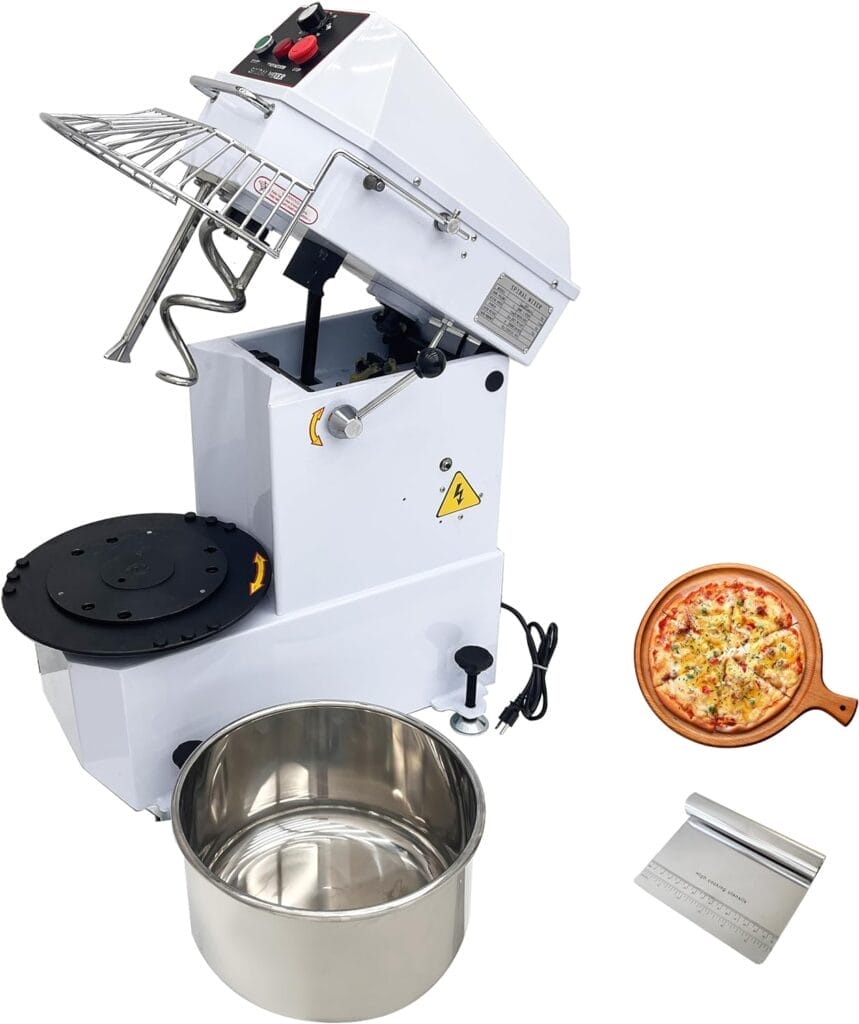
The Ultimate Guide to Choosing the Best
In the world of pizza making, the best pizza dough mixers can make all the difference. At the heart of every mouth-watering pizza is its dough – the base that holds all the delicious toppings together. But achieving that perfect dough consistency isn’t just about the ingredients; it’s also about how you mix them. This is where having a top-notch pizza dough mixer becomes crucial, not just for commercial kitchens, pizza shops, and catering businesses, but also for food trucks and home pizza enthusiasts.
Why the Best Pizza Dough Mixers are Key to Pizza Perfection
Creating the perfect pizza dough is both an art and a science. It requires precision, the right timing, and the ability to replicate the process consistently. This is precisely why your choice of mixer can significantly impact the quality of your pizza. The right mixer should not only blend ingredients efficiently but also do so in a way that enhances the dough’s texture and flavor.
Different Types of Dough Mixers
Before diving into the features that make a great dough mixer, it’s essential to understand the types available on the market:
Spiral Mixers
Designed specifically for dough mixing, spiral mixers are a favorite in many professional kitchens. They mix dough gently, allowing for proper gluten formation without overworking the dough. This type of mixer is perfect for high-hydration doughs, such as those used in Neapolitan and other artisan pizzas.
Planetary Mixers
Versatile and multifunctional, planetary mixers are equipped with various attachments, making them suitable for a broad range of tasks beyond just mixing dough. They’re ideal for kitchens that prepare various menu items requiring different mixing techniques.
Fork Mixers
Fork mixers replicate the motion of hand kneading, making them ideal for producing a traditional, airy pizza dough. They’re especially popular among chefs specializing in Italian-style pizzas.
Key Features to Look for in the Best Pizza Dough Mixers
When choosing a mixer for pizza dough, several features stand out as particularly important:
- Motor Strength: A powerful motor ensures your mixer can handle dense doughs without straining.
- Capacity: The size of the mixer’s bowl will determine how much dough you can make at once. Consider the volume of pizza you plan to produce daily.
- Speed Settings: Having variable speed settings allows for more control over the mixing process, which can be crucial for developing the perfect dough texture.
- Durability: Commercial kitchens need machines that can withstand heavy use. Look for mixers made from high-quality materials that promise longevity.
- Ease of Cleaning: Time is of the essence in professional kitchens. Mixers that are easy to clean will save you time and effort.
The Best Pizza Dough Mixers on the Market
Let’s take a closer look at some models that have received rave reviews from pizza professionals and enthusiasts alike:
The Spiral Perfectionist: The Hobart Legacy Spiral Mixer
This mixer is a powerhouse, known for its durability and efficiency. Perfect for high-volume establishments, the Hobart mixer can handle large batches of dough with ease, ensuring uniform texture every time.
The Versatile Performer: KitchenAid Professional Stand Mixer
For smaller kitchens or home enthusiasts, the KitchenAid Stand Mixer, with its dough hook attachment, does an admirable job. While not exclusively a dough mixer, its performance on pizza dough is noteworthy for its price point and versatility.
The Traditional Choice: Famag Grilletta IM 5S
The Famag mixer is a fork mixer that excels in making traditional Italian pizza dough. Its slow kneading action creates a beautifully aerated dough, mimicking the traditional hand-kneading process.
Making the Most of Your Mixer
Owning the best pizza dough mixer is the first step. Here are some tips to ensure you get the best results:
- Always start with the liquid ingredients and add the flour gradually. This helps to prevent flour clumping and ensures a smoother dough.
- Use the mixer’s slow speed setting to start the mixing process. Once the ingredients are roughly combined, increase the speed to develop the dough’s gluten network.
- Don’t overmix. Keeping an eye on the dough’s consistency is crucial; overmixing can lead to tough pizza bases.
- Regular maintenance is key. Regular checks and cleaning can prolong your mixer’s life and ensure it performs at its best.
Conclusion
Selecting the right pizza dough mixer can elevate your pizza game, whether you’re running a bustling pizza joint or just passionate about making pizza at home. Considering the mixer’s type, capacity, motor strength, and other features will help you make an informed decision. Remember, the best mixer for you is one that fits your specific needs, allowing you to consistently produce high-quality pizza dough.
By investing time into choosing the right mixer and learning to use it effectively, you’re not just buying a kitchen tool; you’re setting the foundation for countless delicious pizzas to come. So, take the plunge, pick the mixer that best suits your pizza-making journey, and get ready to delight in the magic of perfect pizza dough every time.
No products found.
The Great Pizza Dough Debate: Mixer or Hand Knead?
Pizza, universally beloved, comes in various forms, but at its heart, the key to a perfect pizza is undoubtedly the dough. The long-standing debate in both commercial kitchens and among home cooking enthusiasts is whether to use a mixer for kneading pizza dough or to do it by hand. In this comprehensive blog post, we dive deep into this debate, providing insights and advice to commercial kitchens, pizza shops, catering businesses, food trucks, and home pizza enthusiasts alike. Prepare to uncover the art and science behind making the perfect pizza dough. Start the process with the best pizza dough mixers.
Understanding Pizza Dough: The Foundation of a Great Pizza
Pizza dough might seem simple at first glance, with its few ingredients — flour, water, yeast, and salt. However, creating a dough that rises beautifully, cooks to a gentle crisp on the outside while remaining soft and chewy on the inside, is an art form. The key processes in dough development are mixing, kneading, and fermentation. These stages develop gluten, which gives the dough its structure and texture, and allow for the fermentation process to impart flavor and lightness.
The Role of Mixing and Kneading in Dough Development
- Gluten Formation: The primary goal of mixing and kneading is to combine ingredients and develop gluten, the protein network that provides dough with elasticity and strength.
- Consistency and Texture: Proper kneading ensures the dough is uniformly mixed, resulting in a consistent texture in the final product.
- Aeration: Mixing and kneading incorporate air into the dough, which is essential for the fermentation process and contributes to the light, airy texture of the pizza base.
Given these critical roles, the method chosen for mixing and kneading not only impacts the dough’s texture and flavor but also the efficiency and scalability of pizza production, especially in a commercial setting.
To Mix or Not to Mix: That is the Question
The decision to use a mixer for pizza dough lies at the intersection of tradition, practicality, and preference. Here, we’ll explore the pros and cons of using a mixer for making pizza dough, and compare it to the traditional hand-kneading method.
Pros of Using a Mixer
- Efficiency and Time-saving: For commercial kitchens and pizza shops, time is of the essence. Mixers can significantly reduce the time and labor involved in kneading dough, allowing for the preparation of large batches simultaneously.
- Consistency: Mixers offer a level of consistency in dough texture that is hard to achieve by hand, which is crucial for businesses aiming to maintain a consistent product.
- Ease of Use: Especially for beginners or those with physical limitations, a mixer can make the dough-making process more accessible and less physically demanding.
Cons of Using a Mixer
- Over-kneading Risk: There’s a fine line between well-kneaded dough and over-kneaded dough, which becomes tough and loses its texture. Mixers, especially in inexperienced hands, can easily cross this line.
- The Cost: High-quality mixers are an investment. For small businesses or home enthusiasts, the cost might not be justifiable.
- Losing the Traditional Touch: Some argue that hand-kneading adds a personal touch to pizza making, and this traditional method can be more satisfying and meditative for the person making it.
Hand-Kneading: An Age-Old Tradition
On the other side of the debate, hand-kneading is cherished for its tradition, simplicity, and the tactile experience it offers. It allows for more intuitive control over the dough’s development, letting the baker adjust their technique based on the dough’s feel. This method requires no special equipment, just time, patience, and a touch of love.
Making the Choice: Mixer or Hands?
When deciding whether to use a mixer for pizza dough, consider the following factors tailored to your specific situation:
- Scale of Production: Commercial settings, where large volumes of dough are required, might find the efficiency of a mixer indispensable. In contrast, small batches for home cooking can be easily managed by hand.
- Skill Level and Preferences: Those who enjoy the process of hand kneading and have the skill to do it well might prefer the traditional method. Beginners or those looking for consistency and efficiency might lean towards using a mixer.
- Budget and Space: Consider the initial investment and space required for a mixer. In commercial kitchens, this might be a non-issue, but for home kitchens, space and budget constraints might make hand kneading more appealing.
Conclusion: Harmony Between Tradition and Technology
The decision to use a mixer or knead by hand doesn’t have a one-size-fits-all answer. It depends on the specific needs, preferences, and constraints of the pizza maker. For commercial kitchens and pizza shops where efficiency and consistency are paramount, investing in a quality mixer makes sense. For home pizza enthusiasts who cherish the process and tradition of pizza making, hand kneading offers a satisfying and personalized approach to dough creation.
The key takeaway here is that both methods, when executed correctly, can produce exceptional pizza dough. Experimenting with both techniques, understanding the nuances of dough development, and respecting the craft of pizza making are what will elevate your pizza, whether it’s being served to a crowd of eager customers or enjoyed at home with family and friends. Regardless of your choice, the journey of mastering pizza dough is a rewarding one, filled with delicious outcomes and the joy of creation. Happy kneading!
Check Out Some Of Our Other Reviews
https://socialspiker.com/best-air-purifier-for-baby
https://socialspiker.com/how-to-find-the-best-commercial-pizza-oven



